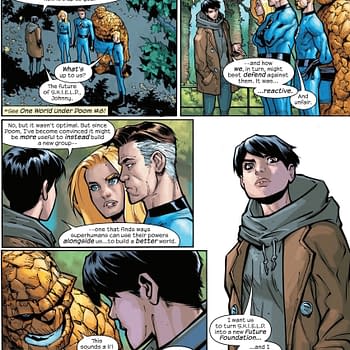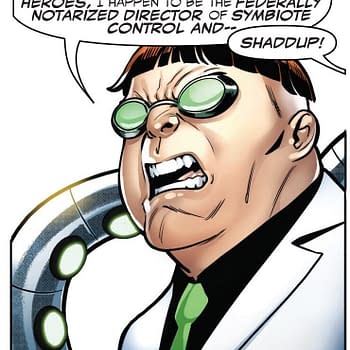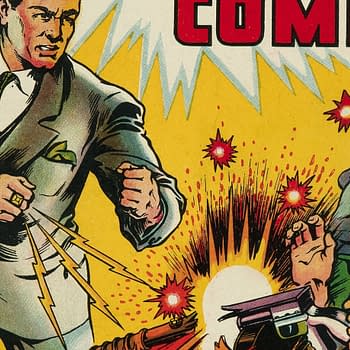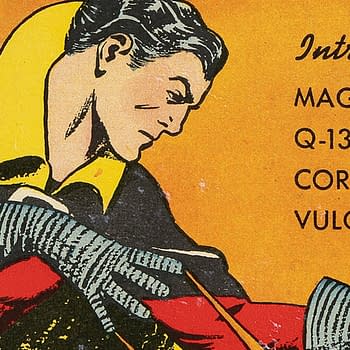Posted in: Comics, Look! It Moves! by Adi Tantimedh | Tagged: Comics, dc, justice league
Look! It Moves! by Adi Tantimedh #120: How I Wrote The Steampunk Justice League Part 2
Welcome to part 2 of my reminiscing about writing JLA: AGE OF WONDER. Are you sitting comfortably? Then we'll begin some commentary.
SPOILER WARNING: You really should read the book first, otherwise you won't understand a damn thing I'll going to spend the rest of this column talking about.
Designing the Steampunk Justice League
Other than Superman, we picked the members for the League specifically from science-based characters, hence Barry Allen, Ted Knight, basing the latter's design on a 19th century version of the popular plainclothes look of Jack Knight since James Robinson's STARMAN was at its peak at the time. We wanted Hal Jordan as a soldier who became Green Lantern and give him the moral dilemma that leads to his act of betrayal and downfall, and his uniform would be a modified version of a US soldier's uniform. Plastic Man's look didn't need to change at all. Batman's look would be the same as the one from a previous Batman Elseworlds GOTHAM BY GASLIGHT. Wonder Woman's costume would be the type of design you get from Victorian idealization of Roman armour. The most radical design, with instruments and circuitry exposed as external attachments. Superman's costume would be something like the one from the Superman Elseworlds set in the American Civil War, SUPERMAN: A NATION DIVIDED.
PART 1:
The thinking behind the series was that there were no superheroes during the Industrial Revolution. Clark Kent would be inspired by the explosion of scientific innovation and invention at the time, "Steam Engine Time", as it were, so when he gathered scientists and inventors around him like Barry Allen, Ted Knight and Nikola Tesla in the beginning.
Lois Lane here is based on the Gibson Girl as girls drawn by the illustrator Charles Dana Gibson in the late 19th Century.
I'd written a scene where Lois takes Clark to a tailor to get what would eventually become his uniform. It is one of the worst scenes I had ever written in my life and Andy mercifully told me it would be omitted.
That panel of Clark getting zapped by lightning is a visual callback to this 1940s SUPERMAN cover:
I wanted the drastic change the world went through because of Clark Kent's intervention to be show visually without the need for captions and narration, and how better to do this than show the change in architecture, the emergence of glamourous, gleaming spires like a dreaming city that sprang up during Clark's first decade as The Superman. Who better to design the cityscapes here than P. Craig Russell and Galen Showman? They took a lot of time researching the visual references and then getting the art right, which was one reason why the book took so long to draw.
I never actually spoke to Craig or Galen during the time the book was being scripted and drawn. Andy handled all communication with the artists. Craig did the breakdowns and would occasionally add panels to improve the rhythm of a scene. He was a master at it. One page even had eleven panels in it and I had limited myself to nine, since I wasn't going to torture my artists. Craig did it on his own accord, and the graphic of each page still take my breath away. I only had an email exchange with Craig after the book was finished.
What I enjoyed most with writing Part 1 was all the scenes where the characters debated ideas and themes, pondering the implications of Science and Progress and War. Took a while to get right since you couldn't have speeches go on and on. That was probably where the BBC training kicked in, since the old plays on BBC TV and Radio 4 were very upfront about having characters overtly state and argue about themes and ideas. I especially enjoyed the Green Arrow scene, which was the culmination of all those debates in Part 1. I was very conscious that with the availability of printing presses, the Industrial Revolution saw an increase in the number of political manifestos and leaflets from groups of all political and religious persuasions. THE COMMUNIST MANIFESTO was published in 1848 and of course, by 1900, not only was that circulating, but so were all kinds of anarchist manifestos calling for violent revolt. I wanted to get that atmosphere in the story.
Two scenes that were cut:
One was where Clark and Lois met a 12-year-old Princess Diana visiting America as part of an Amazonian diplomatic mission after Superman discovers the existence of Themyscira. The little girl would be able to fly and expressed discomfort with the dresses she was forced to wear, under the eye of her appointed governess, a fretful Etta Candy. That might have lent the appearance of the sadder adult Wonder Woman in Part 2 more punch. This scene didn't really add to the plot, since by that point we could only really go with essential scenes, and it was cut. It was a really bad scene anyway, the other worst scene I've ever written, and I'm glad no one will ever read it. It was never drawn.
The second scene was the one that introduced Aquaman. A giant octopus would surface at New York Harbour and attack the city and Superman and the League would attack it, only to be stopped by a very pissed-off Aquaman, here named Arthurus Rex, King of Atlantis and the Seven Seas. He would explain that the creature was a mutation whose birth was the result of the radioactive materials that fell into the sea when Superman and the League blew up Luthor's zeppelin. Aquaman would wear exactly same costume he does now, except the golden tunic was a suit of armour made up of hard seashells and his green pants were also a kind of shiny green armour made from the hide of some sea creature he had killed in battle. Galen even drew a design for him. Interestingly, the Aquaman who appears in the DC UNIVERSE ONLINE MMO game looks quite close to what we wanted him to look like here, but I doubt Jim Lee ever saw that design. Aquaman gives the League a stern talking to about industries dumping their toxic waste into the sea and how it might endanger not only the marine life but Atlantis as well, and issues a warning that if the surface world didn't stop dumping their crap into the sea, he would declare war on them. Then he telepathically commands the giant octopus to return to the depth and leaves. The plan was to bring Aquaman back in Part 2 where he would lead Atlantis and the creatures of the sea to help defeat the Germany Navy, and at the end Atlantis would also join the Justice League of Nations.
Over the moon: they're building what would have become the fin-de-siecle version of the JLA Watchtower. I originally planned to have the Camera Obscura play a part in the story in Part 2, a kind of panopticon used to watch over the world from space in a kind of Orwellian scenario. Sadly, there was no room in Part 2 so this was abandoned.
A resolution error resulted in Hal and Luthor's whispered dialogue at the bottom of Page 47 being too blurred to be readable. This is what they said –
Hal: "At the end, I couldn't do it. I'm not a murderer. I sent him back to where he came from."
Luthor: "Well, you'd better hope he doesn't come back!"
PART 2:

Poor Green Arrow. His death was an indication of an even darker era. He was getting older, his joints started to ache, his reflexes not as swift and that led to his downfall. His time is over. It's Batman's time now.
In case you were wondering: Yes, Luthor is having sex with Wonder Woman. He's keeping her as a mistress.
Something we didn't have room to go into detail: Themyscira was at war with the Germans, who fought the Amazons to a standstill with advanced weapons Luthor had secretly supplied them. The queen entrusted Diana to Luthor's care in America to keep her safe and ensure a successor should the queen die in battle. Wonder Woman only agreed to help Luthor because he promised he would help defeat the Germans and free her home. The pay-off would have been a scene near the end where Superman and League fought with the Amazons to defeat the German army and navy. Again, this didn't make it even to script stage because of lack of space, as did a scene of Superman and Batman bringing Diana's body back to Themyscira to a grieving Queen.
One fascinating discovery in my research was finding that Science Fiction novels about international and global wars fought with zeppelins and airships were hugely popularly by the end of the 19th Century and all through the 1900s before the First World War broke out. Even H.G. Wells wrote one in 1997, THE WAR IN THE AIR, which featured New York being bombarded by German flying machines. The novels, mostly British, seemed to have a consensus that Germany was the enemy. Part 2 of AGE OF WONDER is partly a pastiche of that school of early 20th Century Science Fiction, which you could consider a precursor of the Steampunk genre as we know it now. I should like to point out that the Steampunk genre was really established by Michael Moorcock in his Oswald Bastable trilogy that consisted of THE WARLORD OF THE AIR, THE LAND LEVIATHAN and THE STEEL TSAR, all written in the 1970s and set in an alternate universe Edwardian era, where Moorcock wrote to deconstruct and comment on the politics of those earlier novels from the 1900s. And again, I wanted to introduce that pastiche to AGE OF WONDER here.
I toyed with Lois Lane investigating a hidden weapons bunker in the mountains of Bavaria that Luthor had kept for the Germans, discovering the nuclear warheads there and dying from radiation exposure. Andy vetoed it as too dark, and even a friend shuddered upon hearing it and said, "Damn, that's cold!" They were right. Things were bleak enough as it was by now. I also toyed with Luthor still having a thing for Lois but Andy said, "Nah, it's been ten years. He's over her by now."
It's quite normal for editors at DC and Marvel to rewrite or insert new dialogue into the story to clarify things. Andy added the wino commenting that no man could survive the warehouse explosion, though I didn't think that was necessary. He also added quite a few "What have I/we done?" throughout Part 2 whereas I only wrote it once in Part 2, where London gets nuked and Hal shouts "What have we done!" I didn't write the other "what have I/we done?" instances in the rest of Part 2. Not that any of this was a problem to the story.
Batman is so easy to write. Even Andy liked this page so much he didn't change any of the dialogue. He seemed to especially like "…I won't break your other arm."
That image of Superman ripping off the top of the German tank is a visual callback to the cover of the original Action Comics #1 from 1938.
Tesla's death-ray was based on plans he drew up but never realized at Wardenclyffe. So of course he gets to build it in our story!
And of course we blow it up at the end!
Sigh… I'm not happy with how we portrayed Wonder Woman as a depressed mistress of Lex Luthor's who finally redeems herself by dying. I certainly didn't want to kill her off but Andy and I were so exhausted by the time we were plotting Part 2 that we couldn't think of any other way to do it and also have one final tragedy in the story. If I were writing this today, I'd probably have had Diana and the Amazons on the frontline in pitched battle against German invasion forces on Themyscira. Instead, I just had her as beaten-down, despairing and hoping it would all be over soon… WAIT! OH MY GOD! SHE WAS ME AT THAT TIME!!!
Ahem. Oh well. All fiction is autobiographical, whether intentional or not.
Interestingly, I've found that my favourite scene to write in the whole story is that final jailhouse conversation between Luthor and Superman. No action, just one last quiet verbal fight full of more than 20 years' of meaning between these two men. Luthor's character arc was the most satisfying part of the story for me, as we get to see his evolution from an opportunistic man in his late 20s to an embittered, power-hungry megalomaniac in his fifties before the end.
"The Justice League of Nations" is meant to be loaded with meaning, since in our history, the League of Nations was an ineffectual mess and ultimately a failure. You can either take the Justice League of Nations as a mess waiting to happen or something that's going to be done right and prevent more wars because Superman is around. I think Andy preferred this resolution, a compromise that comes down on the side of social democratic ideas, as potentially imperfect as it might be. Since there won't be a sequel, I like leaving that ending open for readers to imagine what the future would be like. Superman and Lois have their bittersweet happy ending.
And Batman… Batman doesn't get a happy ending. He just carries on until the day he's not able to anymore.
And that's the end of JLA: AGE OF WONDER. It and Mark Millar's RED SUN were the last Elseworlds to be published after long gestation periods. I'm glad they were good ones. A friend read AGE OF WONDER and complimented me on writing a story that reflected the mood that the war in Iraq had created, though I had to admit I finished writing the script before Iraq was invaded. Odd coincidence, that. Everything I wanted to try with plotting and structure, foreshadowing and paying off but didn't get to do, I would succeed at a few years later when I wrote LA MUSE, which was not torturous at all and an absolute blast to write.
DC COMICS PRESENTS – JLA: AGE OF WONDER is out in comic shops.
Failing to rewrite in the past at lookitmoves@gmail.com
Follow the official LOOK! IT MOVES! twitter feed at http://twitter.com/lookitmoves for thoughts and snark on media and pop culture, stuff for future columns and stuff I may never spend a whole column writing about.
Look! It Moves! © Adisakdi Tantimedh

















